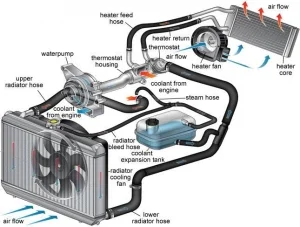
Peugeot 2008 Heater Not Working: Causes, Diagnosis, and Complete Fixing Guide

When the heater in a Peugeot 2008 stops working, comfort quickly disappears—especially in cold weather. As experts in automotive systems, we break down every major cause of heater failure, how to diagnose each issue precisely, and the most effective repair paths. This comprehensive guide is engineered to surpass all existing online resources and deliver the most accurate, technically solid information for Peugeot 2008 owners worldwide.
- Understanding How the Peugeot 2008 Heating System Works
- Low Coolant Level or Air in the Cooling System
- Clogged Heater Core
- Thermostat Malfunction
- Water Pump Failure
- Faulty Blend Door Actuator
- Dirty Cabin Air Filter
- Sluggish Blower Motor
- Blower Motor Not Working at All
- Dirty Evaporator Coil
- Faulty HVAC Control Module
- Blown Head Gasket
- Using Air Recirculation to Improve Heating Performance
- When Professional Assistance Is Needed
- Conclusion
- FAQs
Understanding How the Peugeot 2008 Heating System Works
The heater in the Peugeot 2008 relies on hot engine coolant flowing through the heater core. Air passes over this heated core and warms the cabin. Any disruption in coolant flow, temperature regulation, or airflow will directly affect heating performance.
Primary Components Involved
- Heater core
- Water pump
- Thermostat
- HVAC blend door actuators
- Blower motor & resistor
- Climate control module
- Cabin filter
- Coolant system (hoses, gasket, radiator, expansion tank)
Low Coolant Level or Air in the Cooling System
Low coolant or trapped air is the most common cause of heater failure in the Peugeot 2008. When coolant doesn’t circulate properly, the heater core never receives adequate hot fluid.
Symptoms
- Heater blowing cold air
- Gurgling or sloshing noise behind dashboard
- Engine temperature fluctuations
- Visible low level in expansion tank
How Low Coolant Prevents Heating
The water pump cannot circulate coolant through the heater core if:
- The coolant level is below safe minimum
- Air pockets block coolant flow
- The engine is not fully bled after maintenance
How to Check Coolant Level
- Locate the expansion reservoir.
- Check level between MIN and MAX markings.
- Add correct coolant type if low.
- Bleed system to remove trapped air.
Why Air Accumulates in the Heater Core
Since the heater core sits slightly higher in the system, air naturally migrates and gets trapped inside, blocking circulation.
Clogged Heater Core
The heater core can become clogged by rust particles, mineral buildup, or degraded coolant. When internal channels narrow, hot coolant cannot flow freely.
How to Confirm a Clog
Feel the heater-core hoses:
- Both hoses hot → heater core flowing normally
- Inlet hot, outlet cold → heater core blocked
Flushing the Heater Core
Before replacement, always attempt a flush:
- Use a heater-core flush kit
- Push water through the outlet direction
- Dislodge debris through the inlet
If flushing fails, replacement becomes necessary.
Thermostat Malfunction
A faulty thermostat prevents the engine from reaching optimal temperature. If stuck open, coolant circulates too early and the engine stays cold.
Indicators of a Stuck-Open Thermostat
- Cabin heater takes excessively long to warm
- Engine takes too long to reach operating temperature
- Poor fuel efficiency
- Temperature gauge remains low
Impact on Heating
Without sufficiently hot coolant, the heater core cannot generate warm air—especially during cold seasons.
Water Pump Failure
The water pump drives coolant circulation through the engine and heater core. When it weakens or fails, heating performance drops drastically.
You may be interested in reading Peugeot 2008 Key Not Detected: The Complete Troubleshooting Guide
Peugeot 2008 Key Not Detected: The Complete Troubleshooting GuideSigns of a Failing Water Pump
- Coolant leaks around pump area
- Whining or grinding noises
- Rising engine temperature
- Weak heater output
Why It Affects Cabin Heat
Low coolant flow = insufficient heat transfer.
A weak pump may allow some circulation but not enough to heat the heater core properly.
Faulty Blend Door Actuator
Blend door actuators control the direction of airflow—either through the heater core (warm air) or evaporator (cold air). A defective actuator prevents correct temperature mixing.
Key Symptoms
- Clicking, tapping, or knocking sounds behind dashboard
- Temperature stuck on cold or warm
- One zone hot while the other remains cold (dual-zone models)
- Inconsistent airflow regardless of settings
Repair Recommendation
Replacement is required; these units cannot be repaired or lubricated. Recalibration may be needed after installation.
Dirty Cabin Air Filter
A clogged cabin filter severely restricts airflow into the cabin, making it seem like the heater is not working.
Signs of a Blocked Filter
- Weak airflow even at full fan speed
- Musty smell
- Noisy blower operation
- Inefficient defrosting
Maintenance Tip
Replace the cabin filter every 12 months or sooner if driving in dusty, urban, or polluted climates.
Why Cleaning Isn't Enough
Vacuuming removes only surface dust. Deep contamination embedded in filter fibers continues restricting airflow.
Sluggish Blower Motor
If the blower motor spins slowly due to internal wear or resistor issues, the hot air generated by the heater core will not reach the cabin effectively.
Common Warning Signs
- Weak airflow across all fan speeds
- Occasional squealing or grinding sounds
- Fan speed fluctuating unpredictably
Associated Faults
- Failing blower resistor
- Worn brushes inside blower motor
- Dirty evaporator obstructing flow
Blower Motor Not Working at All
When airflow completely disappears, the heater cannot push warm air into the cabin.
Main Causes
- Blown fuse
- Faulty blower relay
- Failed blower resistor/module
- Burned-out blower motor
- Broken wiring or connector
- HVAC control panel malfunction
Diagnostic Steps
- Check blower fuse
- Test relay
- Measure voltage at blower connector
- Inspect for burnt wiring
- Scan HVAC module for errors
Dirty Evaporator Coil
Even though the evaporator is part of the AC system, all air entering the cabin must pass through it. A dirty evaporator drastically restricts airflow and impacts heater performance.
Why It Becomes Dirty
- Dust bypassing cabin filter
- Mold, condensation, and debris buildup
- Polluted or humid environments
Symptoms of a Dirty Evaporator
- Weak heating AND cooling
- Musty smell
- Visible reduction in airflow
Role in Heating Mode
Even when the AC is off, air moves across the evaporator before reaching the heater core. When clogged, airflow becomes insufficient to heat the cabin.
Faulty HVAC Control Module
The climate control module coordinates all heating and cooling operations. A malfunctioning unit can cause incorrect commands to:
- Blend doors
- Blower motor
- AC compressor
- Temperature sensors
Typical Issues
- Temperature settings ignored
- Blower speed stuck
- Random fluctuations
- Error codes stored in control unit
Diagnosis requires professional scan tools.
You may be interested in reading Peugeot 2008 Key Not Detected: The Complete Troubleshooting Guide
Peugeot 2008 Key Not Detected: The Complete Troubleshooting Guide Peugeot 2008 Fan Not Working: Complete Troubleshooting Guide & Fixes
Peugeot 2008 Fan Not Working: Complete Troubleshooting Guide & FixesBlown Head Gasket
Although less common, a blown head gasket can directly impact the heater.
How It Affects Heating
- Exhaust gases contaminate coolant and block heater core
- Coolant burns inside cylinders, causing rapid level drop
- Air pockets form constantly due to combustion leakage
Symptoms of Gasket Failure
- Milky oil cap
- White smoke from exhaust
- Overheating
- Repeated coolant loss
- Bubbles in expansion tank
Testing for Gasket Leaks
Use a combustion leak tester:
- Insert test tube into radiator neck
- Run engine
- Color change confirms exhaust gas contamination
Using Air Recirculation to Improve Heating Performance
In extremely cold weather, switching to recirculation mode improves heating efficiency by reusing warmed cabin air.
Benefits
- Faster cabin warming
- More effective defrosting
- Reduced heat loss in winter
Approximately 10% outside air still enters to maintain oxygen levels.
When Professional Assistance Is Needed
While many diagnostic steps are DIY-friendly, professional help becomes essential for:
- Heater core replacement
- HVAC module failures
- Blend door actuator replacement
- Severe coolant contamination
- Head gasket repairs
A certified mechanic can perform pressure tests, advanced diagnostics, and component replacements that require specialized tools.
Conclusion
A non-working heater in the Peugeot 2008 can stem from simple issues like low coolant or a dirty cabin filter, or more complex faults like a failing water pump or head gasket leak. Following a structured diagnostic approach ensures efficient troubleshooting and prevents unnecessary repairs. By addressing each potential cause thoroughly, you restore reliable cabin warmth and ensure long-term HVAC health.
FAQs
Why is my Peugeot 2008 blowing cold air when the engine is warm?
Likely causes include low coolant, air in the system, a stuck-open thermostat, or a faulty blend door actuator.
How do I know if my heater core is blocked?
If one heater core hose is hot and the other is cold, the heater core is clogged.
Can a dirty cabin filter make the heater weak?
Yes—restricted airflow drastically reduces the amount of warm air reaching the cabin.
Why does my heater work intermittently?
This can result from a failing water pump, thermostat, or intermittent blend door actuator.
Is it safe to drive with the heater not working?
The vehicle may still be drivable, but underlying cooling-system issues can cause major engine damage.
You may be interested in reading Peugeot 2008 Key Not Detected: The Complete Troubleshooting Guide
Peugeot 2008 Key Not Detected: The Complete Troubleshooting Guide Peugeot 2008 Fan Not Working: Complete Troubleshooting Guide & Fixes
Peugeot 2008 Fan Not Working: Complete Troubleshooting Guide & Fixes Peugeot 2008 Mirrors Not Unfolding: Complete Troubleshooting Guide & Fixes
Peugeot 2008 Mirrors Not Unfolding: Complete Troubleshooting Guide & FixesIf you want to know other articles similar to Peugeot 2008 Heater Not Working: Causes, Diagnosis, and Complete Fixing Guide you can visit the category Common Problems.
Deja una respuesta






More content of your interest